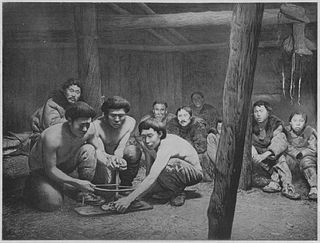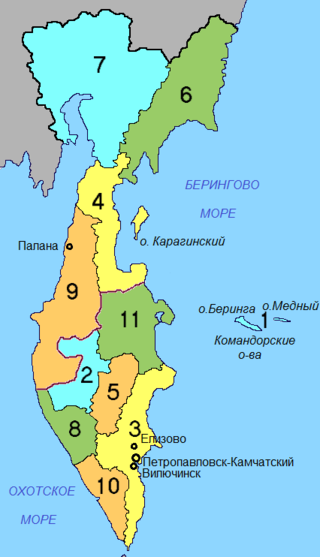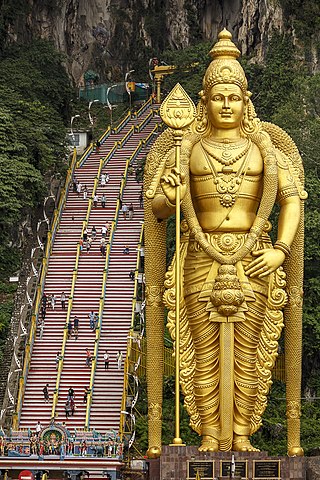
Anapel is the goddess of reincarnation and birth worshipped by the Koryak people of Siberia. Her name means "Little Grandmother" in the Koryak language. She was worshipped at ceremonies following the birth of a new child.

Anapel is the goddess of reincarnation and birth worshipped by the Koryak people of Siberia. Her name means "Little Grandmother" in the Koryak language. She was worshipped at ceremonies following the birth of a new child.

Kamchatka Oblast was, until being incorporated into Kamchatka Krai on July 1, 2007, a federal subject of Russia. To the north, it bordered Magadan Oblast and Chukotka Autonomous Okrug. Koryak Autonomous Okrug was located in the northern part of the oblast. Including the autonomous okrug, the total area of the oblast was 472,300 square kilometres (182,400 sq mi), encompassing the southern half of the Kamchatka Peninsula. The administrative center of Kamchatka Oblast was the city of Petropavlovsk-Kamchatsky. Population: 358,801 (2002 Census); 466,096 (1989 Census).

Koryaks are an Indigenous people of the Russian Far East, who live immediately north of the Kamchatka Peninsula in Kamchatka Krai and inhabit the coastlands of the Bering Sea. The cultural borders of the Koryaks include Tigilsk in the south and the Anadyr basin in the north.

Chukchi, also known as Chukot, is a Chukotko–Kamchatkan language spoken by the Chukchi people in the easternmost extremity of Siberia, mainly in Chukotka Autonomous Okrug. It is one of the only language families to have autonomously produced its own written script, and the northernmost language in the world to have done so through the work of Tenevil. The language is closely related to Koryak. Chukchi, Koryak, Kerek, Alutor, and Itelmen form the Chukotko-Kamchatkan language family. There are many cultural similarities between the Chukchis and Koryaks, including economies based on reindeer herding. Both peoples refer to themselves by the endonym Luorawetlat, meaning "the real people". All of these peoples and other unrelated minorities in and around Kamchatka are known collectively as Kamchadals.

Koryak Okrug, or Koryakia, is an administrative division of Kamchatka Krai, Russia. It was a federal subject of Russia from 1931 until July 1, 2007, when it merged with Kamchatka Oblast. Prior to the merger, it was called Koryak Autonomous Okrug. Its administrative center is the urban locality of Palana. Population: 18,759 (2010 Census); 25,157 (2002 Census); 39,363 (1989 Census).

The Itelmens are an Indigenous ethnic group of the Kamchatka Peninsula in Russia. The Itelmen language is distantly related to Chukchi and Koryak, forming the Chukotko-Kamchatkan language family, but it is now virtually extinct, the vast majority of ethnic Itelmens being native speakers of Russian. A. P. Volodin has published a grammar of the Itelmen language.

The KamchatkaPeninsula is a 1,250-kilometre-long (777 mi) peninsula in the Russian Far East, with an area of about 270,000 km2 (104,248 sq mi). The Pacific Ocean and the Sea of Okhotsk make up the peninsula's eastern and western coastlines, respectively. Immediately offshore along the Pacific coast of the peninsula runs the 10,500-metre-deep (34,449 ft) Kuril–Kamchatka Trench.

Koryak is a Chukotko-Kamchatkan language spoken by 1,665 people as of 2010 in the easternmost extremity of Siberia, mainly in Koryak Okrug. It is mostly spoken by Koryaks. Its close relative, the Chukchi language, is spoken by about three times that number. The language together with Chukchi, Alutor and Itelmen forms the Chukotko-Kamchatkan language family. Its native name in Koryak is нымылан nymylan, but variants of the Russian "Koryak" name are most commonly used in English and other languages.

Guruvayurappan also often rendered Guruvayoorappan, is a form of Vishnu worshipped mainly in Kerala. He is the presiding deity of the Guruvayur temple, who is worshipped as Krishna in his child form, also known as Guruvayur Unnikkannan. Even though the deity is that of chaturbahu Vishnu, the sankalpam (concept) of the people is that the deity is the infant form of Krishna. The deity represents the purna rupa revealed by baby Krishna to his parents Vasudeva and Devaki immediately after his advent in Kamsa's jail. Hence, the deity represents both Krishna and Vishnu. The temple is located in the town of Guruvayur, Thrissur, Kerala, India, which is named after the deity itself.

Kamchatka Krai is a federal subject of Russia, situated in the Russian Far East. It is administratively part of the Far Eastern Federal District. Its administrative center and largest city is Petropavlovsk-Kamchatsky, home to over half of its population of 291,705.
The Alyutors are an ethnic group who lived on the Kamchatka Peninsula and Chukchi Peninsula of the Russian Far East. Today most of them live in Koryak Okrug of Kamchatka Krai.

The Koryak Mountains or Koryak Highlands are an area of mountain ranges in Far-Eastern Siberia, Russia, located in Chukotka Autonomous Okrug and in Kamchatka Krai, with a small part in Magadan Oblast. The highest point in the system is the 2,562-metre high (8,406 ft) Mount Ledyanaya, located in the Ukelayat Range, in the central part of the mountains.

Chukotkan is a dialect cluster that forms one branch of the Chukotko-Kamchatkan language family. It is spoken in two autonomous regions at the extreme northeast of Russia, bounded on the east by the Pacific and on the north by the Arctic.
Pakhachi Airport is an airport in Koryak Okrug, Russia located 2kmW of Ust-Pakhachi. It services small transport aircraft.

Kamchatka Krai was formed on July 1, 2007 as a result of the merger of Kamchatka Oblast with Koryak Autonomous Okrug.

Fedot Alekseyevich Popov was a Russian explorer who organized the first European expedition through the Bering Strait.

Olyutorsky District is an administrative and municipal district (raion) of Koryak Okrug of Kamchatka Krai, Russia, one of the eleven in the krai. It is located in the northeast of the krai. The area of the district is 72,352 square kilometers (27,935 sq mi). Its administrative center is the rural locality of Tilichiki. Population: 5,036 (2010 Census); 7,170 (2002 Census); 12,833 (1989 Census). The population of Tilichiki accounts for 34.6% of the district's total population.

Kartikeya, also known as Skanda, Subrahmanya, Shanmukha and Murugan, is the Hindu god of war. He is the son of Parvati and Shiva, the brother of Ganesha and a god whose legends have many versions in Hinduism. Kartikeya has been an important deity in the Indian subcontinent since ancient times, worshipped as Mahasena and Kumara in North India and is predominantly worshipped in the state of Tamil Nadu and other parts of South India, Sri Lanka, Singapore, Malaysia and Mauritius by Tamils as Murugan.

The Places of Worship Registration Act 1855 is an Act of the Parliament of the United Kingdom which governs the registration and legal recognition of places of worship. It applies only in England and Wales, and does not cover the Church of England which is exempt from the Act's requirements. Nor does it affect the Church in Wales, which remains part of the Anglican Communion although it is no longer the Established Church in Wales. Registration is not compulsory, but it gives certain financial advantages and is also required before a place of worship can be registered as a venue for marriages.
Koekchuch is an extinct gender identity recorded among the Itelmens of Siberia. These were male assigned at birth individuals who behaved as women did, and were recorded in the late 18th century and early 19th century.

Koryak Nature Reserve is a Russian 'zapovednik' Located in the north of the Kamchatka Peninsula, in the valley of the Kuyul River in the Russian Far East, and in separate coastal areas on the coast of the Bering Sea. The reserve includes the surrounding mountains of the Gauvin Peninsula and adjacent waters in Lavrov Bay, and one fourth of the total area covers waters of the Bering Sea. Koryak is an important area for large colonies of nesting waterfowl and migratory seabirds; studies have found that the majority of the seabirds migrating along the Kamchatka Peninsula spend their winters in Japan. Protecting this connection was one of the reasons for the establishment of the reserve in 1995. The rivers of Koryak are important spawning grounds for salmon. Also protected are the floral communities of the reserve, which include prime examples of "Bering forest tundra". The reserve is situated in the Koryak Okrug of Kamchatka Krai. The reserve covers an area of 327,106 ha (1,262.96 sq mi). The site is part of a Ramsar wetland area of international importance.